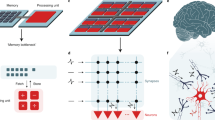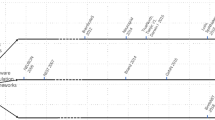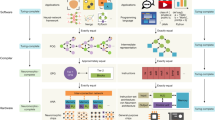Abstract
Hybrid neuromorphic computing supporting the prevailing artificial neural networks and neuroscience-inspired models/algorithms offers substantial flexibility for cross-paradigm model integration. It is one of the most promising technologies for accelerating intelligence development, ultimately contributing to artificial general intelligence development. Recently, an increasing number of hybrid neuromorphic computing chips have been reported, but such research focuses on chip design without demonstrating systems for large-scale workloads. To this end, we construct a multi-grained system based on many Tianjic chips, presenting a large-scale system for hybrid-paradigm brain-inspired computing. With different numbers of chips and different connection topologies, we develop a Tianjic card and a Tianjic board as the infrastructure for building embedded systems and cloud servers, respectively. Extensive measurements of the communication latency, computational latency, and power consumption evidence the superior potential of Tianjic systems for exploring brain-inspired computing for artificial general intelligence.
Similar content being viewed by others
References
LeCun Y, Bengio Y, Hinton G. Deep learning. Nature, 2015, 521: 436–444
Chen Y H, Krishna T, Emer J S, et al. Eyeriss: an energy-efficient reconfigurable accelerator for deep convolutional neural networks. IEEE J Solid-State Circ, 2016, 52: 127–138
Jouppi N P, Young C, Patil N, et al. In-datacenter performance analysis of a tensor processing unit. In: Proceedings of International Symposium on Computer Architecture (ISCA), Toronto, 2017. 1–12
Yin S, Ouyang P, Tang S, et al. A high energy efficient reconfigurable hybrid neural network processor for deep learning applications. IEEE J Solid-State Circ, 2017, 53: 968–982
Roy K, Jaiswal A, Panda P. Towards spike-based machine intelligence with neuromorphic computing. Nature, 2019, 575: 607–617
Merolla P A, Arthur J V, Alvarez-Icaza R, et al. A million spiking-neuron integrated circuit with a scalable communication network and interface. Science, 2014, 345: 668–673
Furber S B, Galluppi F, Temple S, et al. The SpiNNaker project. Proc IEEE, 2014, 102: 652–665
Moradi S, Qiao N, Stefanini F, et al. A scalable multicore architecture with heterogeneous memory structures for dynamic neuromorphic asynchronous processors (DYNAPs). IEEE Trans Biomed Circ Syst, 2017, 12: 106–122
Davies M, Srinivasa N, Lin T H, et al. Loihi: a neuromorphic manycore processor with on-chip learning. IEEE Micro, 2018, 38: 82–99
Deng L, Wu Y, Hu X, et al. Rethinking the performance comparison between SNNS and ANNS. Neural Netw, 2020, 121: 294–307
He W, Wu Y J, Deng L, et al. Comparing SNNs and RNNs on neuromorphic vision datasets: similarities and differences. Neural Netw, 2020, 132: 108–120
Liang L, Hu X, Deng L, et al. Exploring adversarial attack in spiking neural networks with spike-compatible gradient. IEEE Trans Neural Netw Learn Syst, 2021. doi: https://doi.org/10.1109/TNNLS.2021.3106961
Wu J, Chua Y, Zhang M, et al. A tandem learning rule for effective training and rapid inference of deep spiking neural networks. IEEE Trans Neural Netw Learn Syst, 2021. doi: https://doi.org/10.1109/TNNLS.2021.3095724
Wu J, Xu C, Han X, et al. Progressive tandem learning for pattern recognition with deep spiking neural networks. IEEE Trans Pattern Anal Mach Intell, 2022, 44: 7824–7840
Pei J, Deng L, Song S, et al. Towards artificial general intelligence with hybrid Tianjic chip architecture. Nature, 2019, 572: 106–111
Deng L, Wang G, Li G, et al. Tianjic: a unified and scalable chip bridging spike-based and continuous neural computation. IEEE J Solid-State Circ, 2020, 55: 2228–2246
Deng L, Liang L, Wang G, et al. SemiMap: a semi-folded convolution mapping for speed-overhead balance on crossbars. IEEE Trans Comput-Aided Des Integr Circ Syst, 2018, 39: 117–130
Deng L, Zou Z, Ma X, et al. Fast object tracking on a many-core neural network chip. Front Neurosci, 2018, 12: 841
Zou Z, Zhao R, Wu Y, et al. A hybrid and scalable brain-inspired robotic platform. Sci Rep, 2020, 10: 18160
Wang G, Ma S, Wu Y, et al. End-to-end implementation of various hybrid neural networks on a cross-paradigm neuromorphic chip. Front Neurosci, 2021, 15: 615279
Tian L, Wu Z Z, Wu S, et al. Hybrid neural state machine for neural network. Sci China Inf Sci, 2021, 64: 132202
Zhang Y, Qu P, Ji Y, et al. A system hierarchy for brain-inspired computing. Nature, 2020, 586: 378–384
Woźniak S, Pantazi A, Bohnstingl T, et al. Deep learning incorporating biologically inspired neural dynamics and in-memory computing. Nat Mach Intell, 2020, 2: 325–336
S. Höppner, Y. Yan, A. Dixius, et al. The SpiNNaker 2 processing element architecture for hybrid digital neuromorphic computing. 2021. ArXiv:2103.08392
Davidson S, Furber S B. Comparison of artificial and spiking neural networks on digital hardware. Front Neurosci, 2021, 15: 651141
Abbott L F. Lapicque’s introduction of the integrate-and-fire model neuron (1907). Brain Res Bull, 1999, 50: 303–304
Gerstner W, Kistler W M, Naud R, et al. Neuronal Dynamics: from Single Neurons to Networks and Models of Cognition. Cambridge: Cambridge University Press, 2014
Wang Z, Li C, Song W, et al. Reinforcement learning with analogue memristor arrays. Nat Electron, 2019, 2: 115–124
Xue C X, Chiu Y C, Liu T W, et al. A CMOS-integrated compute-in-memory macro based on resistive random-access memory for AI edge devices. Nat Electron, 2021, 4: 81–90
Painkras E, Plana L A, Garside J, et al. SpiNNaker: a 1-W 18-core system-on-chip for massively-parallel neural network simulation. IEEE J Solid-State Circ, 2013, 48: 1943–1953
Akopyan F, Sawada J, Cassidy A, et al. TrueNorth: design and tool flow of a 65 mW 1 million neuron programmable neurosynaptic chip. IEEE Trans Comput-Aided Des Integr Circ Syst, 2015, 34: 1537–1557
Cassidy A S, Alvarez-Icaza R, Akopyan F, et al. Real-time scalable cortical computing at 46 giga-synaptic OPS/watt with 100× speedup in time-to-solution and 100000× reduction in energy-to-solution. In: Proceedings of International Conference for High Performance Computing, Networking, Storage and Analysis, New Orleans, 2014. 27–38
Bi X A, Jiang Q, Sun Q, et al. Analysis of Alzheimer’s disease based on the random neural network cluster in fMRI. Front Neuroinform, 2018, 12: 60
Meszlényi R J, Buza K, Vidnyánszky Z. Resting state fMRI functional connectivity-based classification using a convolutional neural network architecture. Front Neuroinform, 2017, 11: 61
Tu T, Koss J, Sajda P. Relating deep neural network representations to EEG-fMRI spatiotemporal dynamics in a perceptual decision-making task. In: Proceedings of IEEE Conference on Computer Vision and Pattern Recognition Workshops, Salt Lake City, 2018. 1985–1991
Aram Z, Jafari S, Ma J, et al. Using chaotic artificial neural networks to model memory in the brain. Commun Nonlinear Sci Numer Simul, 2017, 44: 449–459
Hale A T, Stonko D P, Lim J, et al. Using an artificial neural network to predict traumatic brain injury. J Neurosurg-Pediatr, 2018, 23: 219–226
Abdalla H E M, Esmail M Y. Brain tumor detection by using artificial neural network. In: Proceedings of International Conference on Computer, Control, Electrical, and Electronics Engineering, Khartoum, 2018. 1–6
Brandli C, Berner R, Minhao Yang R, et al. A 240 × 180 130 dB 3 µs latency global shutter spatiotemporal vision sensor. IEEE J Solid-State Circ, 2014, 49: 2333–2341
Zhao R, Yang Z, Zheng H, et al. A framework for the general design and computation of hybrid neural networks. Nat Commun, 2022, 13: 3427
Acknowledgements
This work was partly supported by National Nature Science Foundation of China (Grant Nos. 62088102, 61836004), National Key R&D Program of China (Grant Nos. 2018YFE0200200, 2021ZD0200300), CETC Haikang Group-Brain Inspired Computing Joint Research Center, IDG/McGovern Institute for Brain Research at Tsinghua University.
Author information
Authors and Affiliations
Corresponding author
Rights and permissions
About this article
Cite this article
Pei, J., Deng, L., Ma, C. et al. Multi-grained system integration for hybrid-paradigm brain-inspired computing. Sci. China Inf. Sci. 66, 142403 (2023). https://doi.org/10.1007/s11432-021-3510-6
Received:
Revised:
Accepted:
Published:
DOI: https://doi.org/10.1007/s11432-021-3510-6




